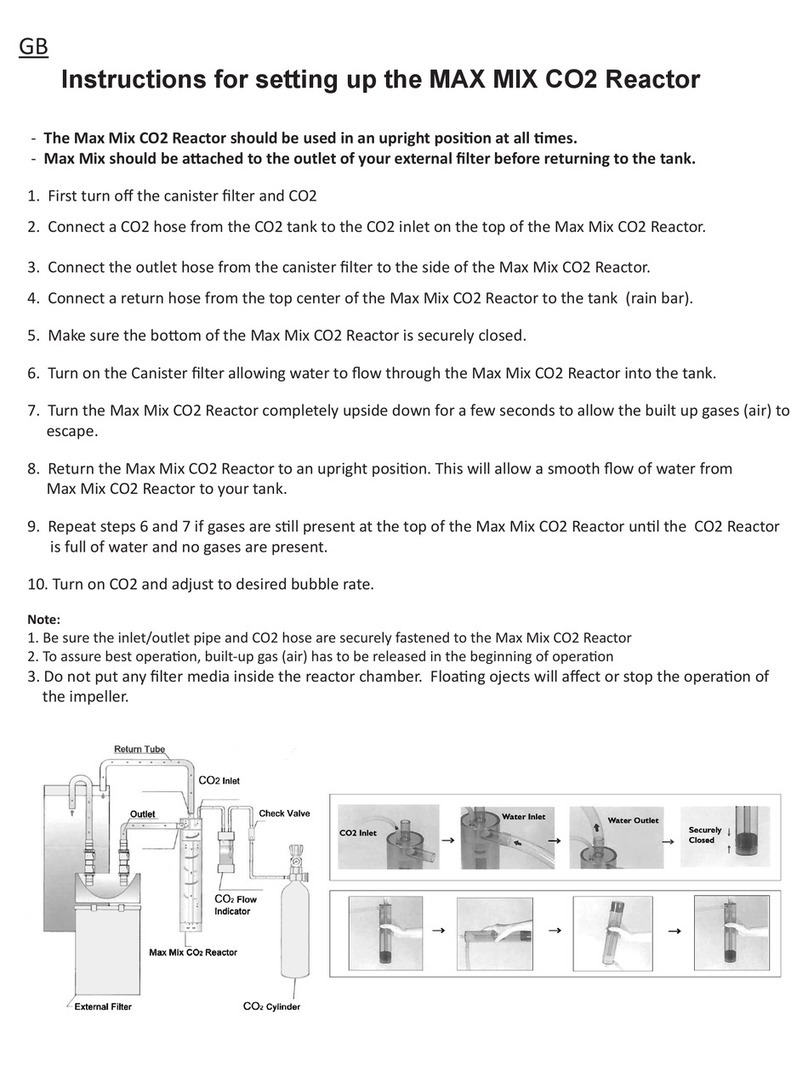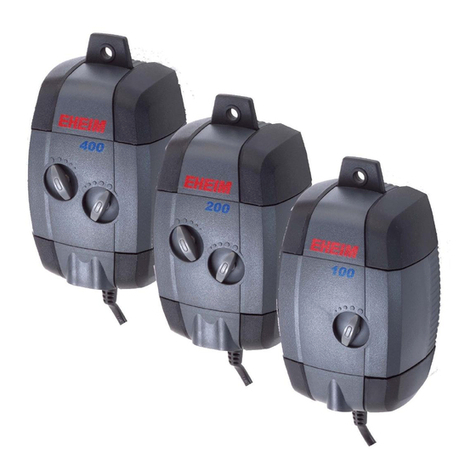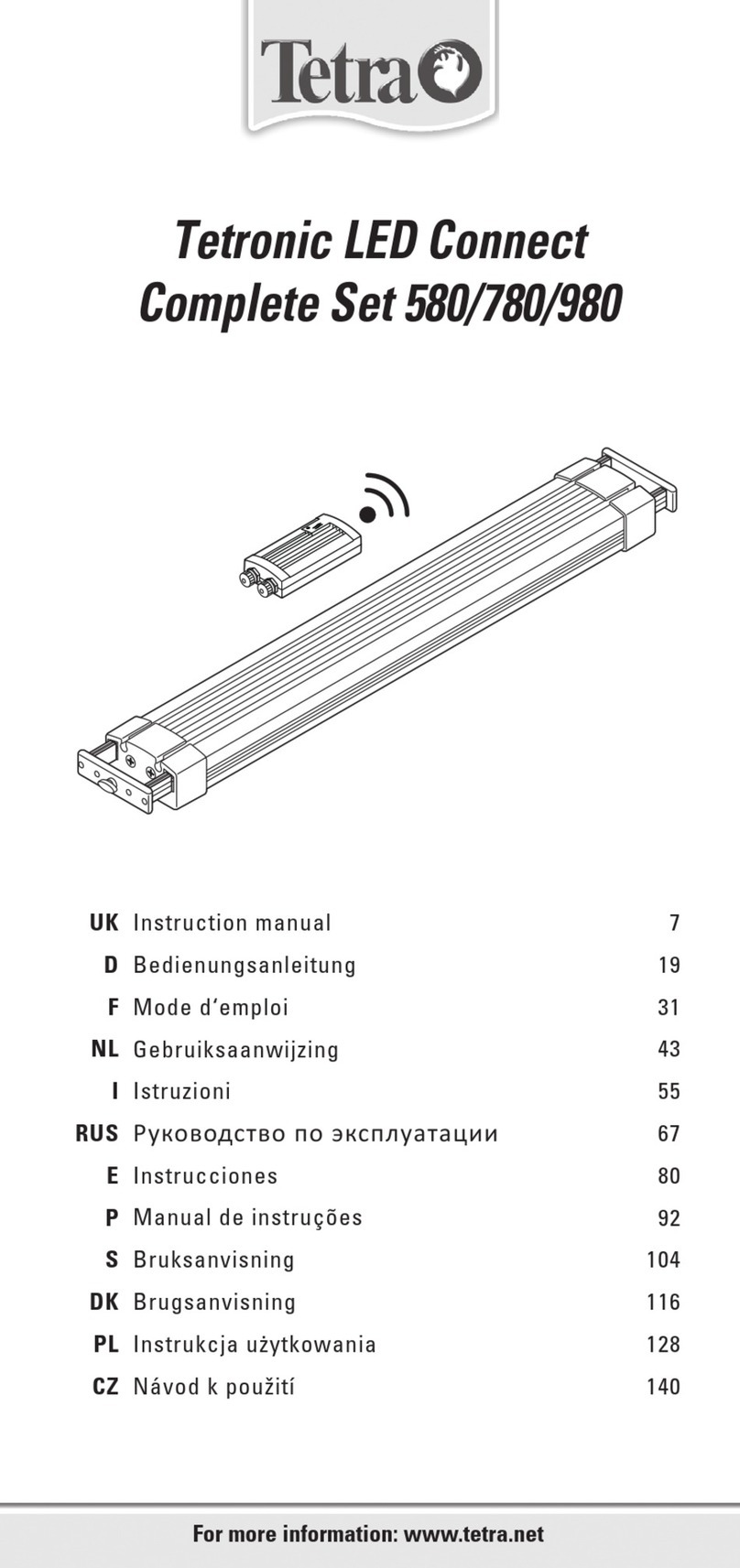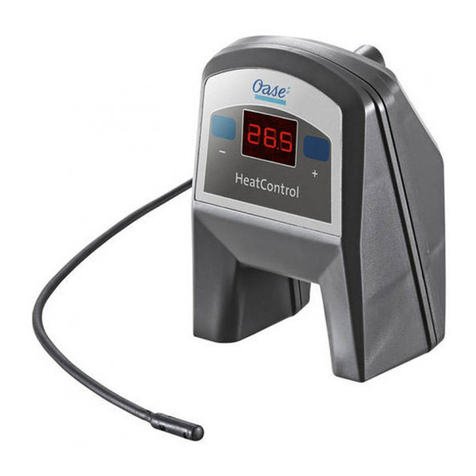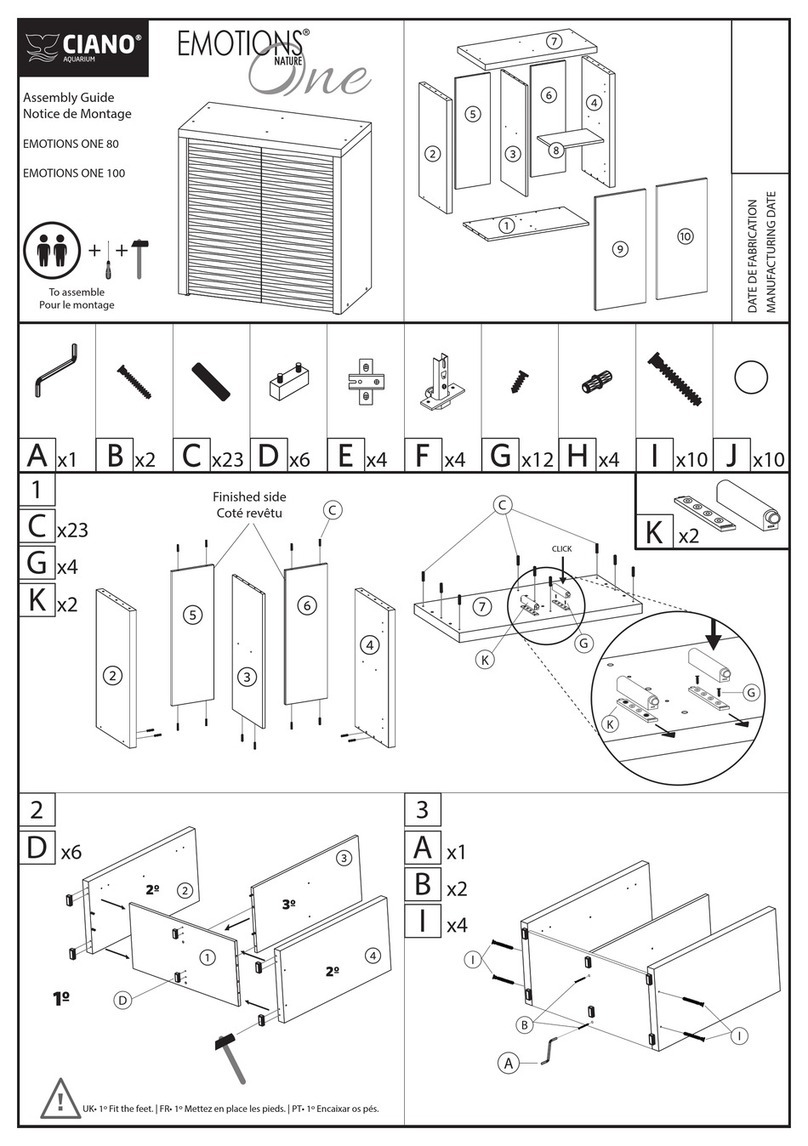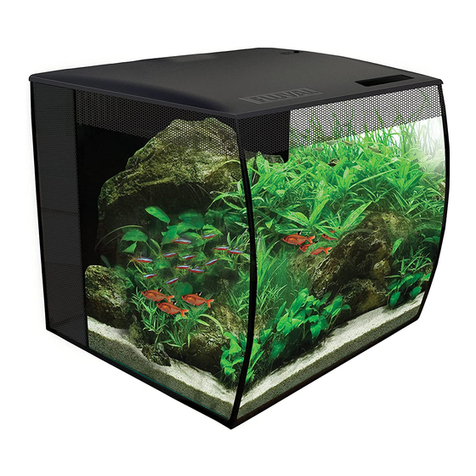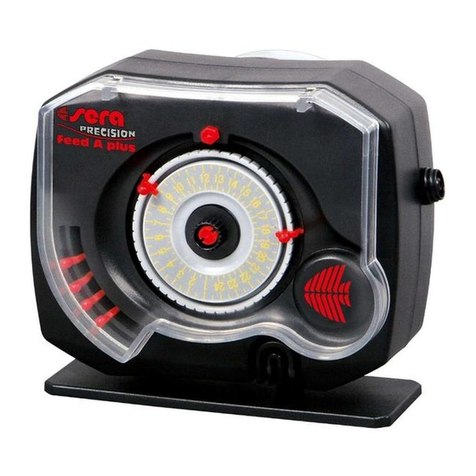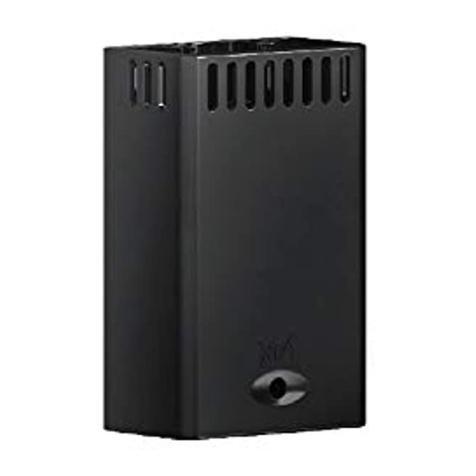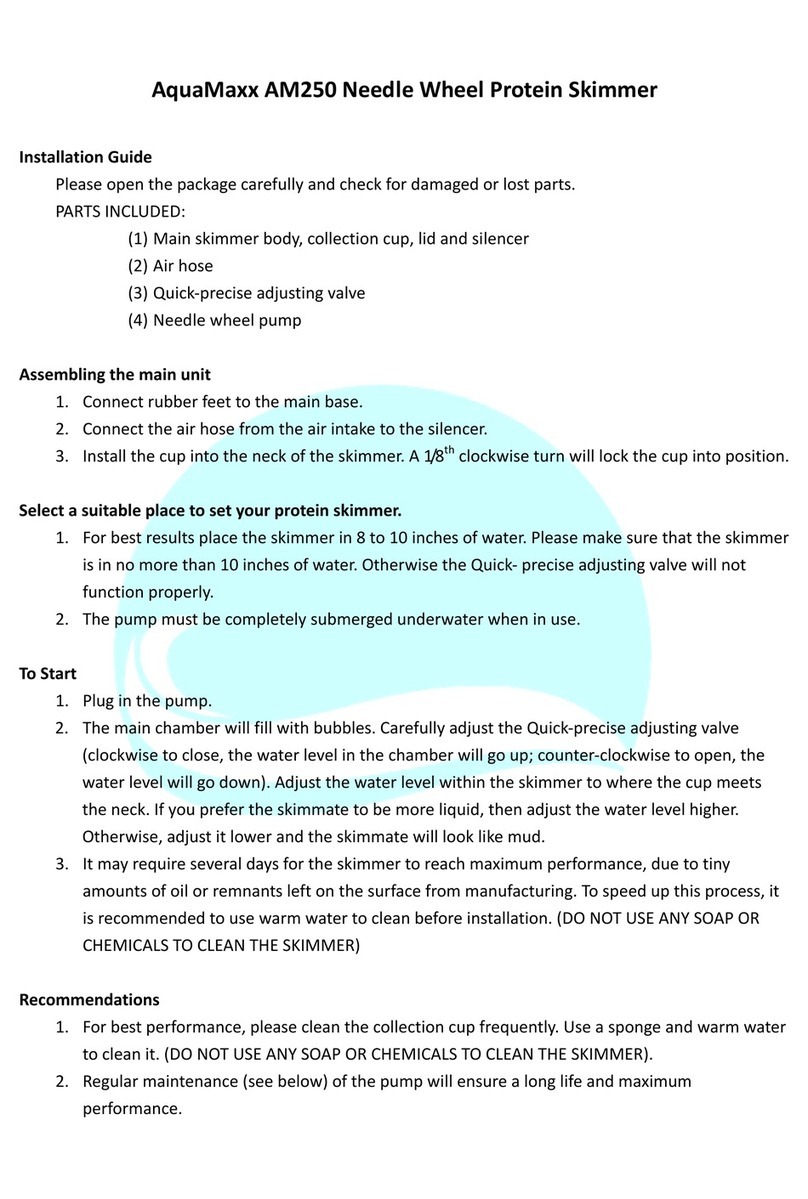Deltec HLP 4040 Guide

®
HLP Pumpen
HLP pumps
Pompe HLP
Pompes HLP
HLP насосы
Bedienungsanleitungen
und Ersatzteillisten
Operating instructions
and Spare parts lists
Istruzioni d‘uso e parti di
ricam io
Instructions d'emploi et
Accessoires et pièces
détachées
Руководство по
обслуживанию и списки
запасных частей

DE
Wichtige Sicherheitshinweise
Warnung: Zum Schutz vor Verletzungen sollten grundlegende Vorsichtsmaßnahmen und folgende Sicherheitshinweise
eachtet werden.
1) Sicherheitshinweise Lesen und efolgen
2) Gefahr: Zur Vermeidung eines elektrischen Schlages sollten alle Aquarium Geräte mit Vorsicht gehandha t
werden. In keinem der unten aufgeführten Fälle sollte die Reparatur vom Kunden versucht werden. Das Gerät
muss zu einen autorisierten Kundendienst ge racht werden.
a) Wenn das Gerät in das Wasser fällt, NICHT danach greifen. Zuerst den Stecker aus der Netzsteckerdose ziehen
und dann das Gerät aus dem Wasser Holen. Wenn Elektroteile des Gerätes nass werden muss das Gerät sofort
ausgesteckt werden.
) Wenn am Gerät ein a normaler Wasseraustritt eo achtet wird, muss es sofort ausgesteckt werden.
c) Nach der Installation sollte das Gerät sorgfältig ü erprüft werden. Es darf nicht eingesteckt werden, wenn sich auf
Teilen, die trocken lei en müssen, Wasser efindet.
d) Ein Gerät mit eschädigtem Ka el oder Stecker darf nicht in Betrie genommen werden. Das gleiche gilt, wenn
das Gerät nicht richtig funktioniert, fallen gelassen oder anderweitig eschädigt wurde.
e) Um ein Nasswerden des Gerätesteckers oder der Steckdose zu vermeiden, sollten der Aquarium Unterschrank
und das Becken seitlich von der Wandsteckdose aufgestellt werden. Somit können keine Tropfen auf den Stecker
oder die Steckdose fallen. Eine „Tropfenschleife“ sollte in jedem Ka el zwischen Aquarium und Wandsteckdose
vorgesehen werden.
Die „Tropfenschleife“ ist der Teil des Ka els, der ei Verwendung eines Verlängerungska els unter der Steckdose
durchhängt (Bild). Auf diese Weise tropft das Wasser unter der Steckdose vom Ka el a und kann nicht mit
dieser in Berührung kommen. Wenn der Stecker oder die Steckdose nass wird, NICHT das Ka el herausziehen,
sondern die Stromversorgung an der Sicherung zw. am Leistungsschalter trennen. Dann erst den Stecker
herausziehen und prüfen, o sich Wasser in der Steckdose efindet.
3) Kinder müssen eaufsichtigt werden, wenn Sie sich am Aquarium oder in dessen nähe Aufhalten.
4) Zur Vermeidung von Verletzungen keine eweglichen oder heißen Teile, wie z.B. Heizungen, Reflektoren ,
Glüh irnen usw. erühren.
5) Bei Nichtverwendung, vor dem Montieren/Demontieren von Teilen oder vor dem Reinigen müssen die etroffenen
Geräte stets ausgesteckt werden. Nicht am Ka el ziehen. Zum Herausziehen des Ka els immer den Stecker
greifen.
6) Die Geräte dürfen nur für den vorgesehenen Zweck verwendet werden. Die Verwendung von Zu ehör, das vom
Hersteller nicht empfohlen oder verkauft wird, kann gefährliche Bedingungen verursachen.
7) Das Gerät nicht an einer Stelle installieren oder lagern, wo es der Witterung oder Temperaturen unter null Grad
ausgesetzt ist.
8) Vor der In etrie nahme eines an der Beckenwand montierten Gerätes muss sichergestellt werden, dass dieses
richtig installiert und efestigt ist.
9) Alle Sicherheitshinweise auf dem Gerät müssen gelesen werden.
10) Wenn ein Verlängerungska el notwendig ist, muss dieses die erforderliche Leistung ha en. Ein Ka el, das für
weniger Ampere oder Watt zugelassen ist, kann sich ü erhitzen. Das Ka el ist so zu verlegen, dass niemand
darü er stolpern oder daran hängen lei en kann.
11) Das Gerät ist mit einem Schukostecker ausgestattet. Dieser Stecker darf auf keine Weise verändert oder
umgangen werden.
Wird der Stecker entfernt erlischt jeder Garantieanspruch!
Diese Anleitung auf ewahren

DE
HLP Pumpen 4040/ 4745/ 5250/ 8070/ 8070S
HLP Pumpen eignen sich durch ihren praktisch geräuschlosen und verschleißfreien Betrie
esonders als Förderpumpen für Aquarien in Innenräumen.
Einbau
Der Ein auort sollte trocken, frostsicher und gut elüftet sein.
Au stellung
Zur esseren Entlüftung sollte die Druckseite senkrecht nach o en zeigen. Die Pumpe ist nicht
sel stansaugend, sie muss unterhal des Wasserniveaus platziert werden.
Die Saugleitung muss so ge aut sein, dass das Wasser der Pumpe frei zugeführt wird und sollte so kurz wie
möglich gehalten werden. Bei längeren Leitungen den nächst größeren Rohrdurchmesser wählen.
Bitte beachten
- Rohrdurchmesser niemals kleiner wählen als durch die Pumpenanschlüsse vorgege en.
- --- Wichtig --- es ist empfehlenswert, die Pumpe durch einen Ansaugkor zu schützen.
- Das Pumpengehäuse muss ei Stillstand immer mit Wasser gefüllt sein.
- Durch den möglichen Ein au eines Rückschlagventils in der Druckleitung wird ein Wideranlaufen nach
Stromausfall/Stillstand gewährleistet.
- Die Fördermenge wird estimmt durch die Förderhöhe und den Durchflusswiderstand; lange
Rohrleitungen, Rückschlagventile und eine große Anzahl von Winkeln können die Fördermenge erhe lich
reduzieren.
Wartung
Unter normalen Betrie s edingungen ist eine Wartung/Reinigung nicht erforderlich.
Im Seewasser ist jedoch durch den Betrie von Kalkreaktoren und Kalkwassermischern eine Verkalkung der
Pumpen nicht auszuschließen. Um einen stillstand durch Kalka lagerungen zu vermeiden, sollten die Pumpen
ca. alle 6 Monate oder ei Bedarf häufiger, mit einem handelsü lichen Entkalker gereinigt werden.
Sicherheitshinweise
- Pumpe nie unter Wasser etrei en.
- Bei Ar eiten am Aquarium immer den Pumpennetzstecker ziehen.
- Vor Ar eiten an der Pumpe immer den Pumpennetzstecker ziehen.
- Pumpe nie an der Zuleitung tragen.
- Pumpe nur mit einem Fehlerstromschutzschalter (<30 mA) etrei en.
- WICHTIG: Bei dem Ein au der Pumpe ist durch geeignete technische Maßnahmen oder regelmäßige
Ü erprüfung sicher zu stellen, dass es ei Fehlfunktionen oder Ausfall der Pumpe zu keinen Tierverlusten
oder anderen Folgeschäden kommen kann.
Technische Daten HLP 4040 HLP 4745 HLP 5250 HLP 8070 HLP 8070S
Fördermenge max. 4.200 Ltr./Std. 5.000 Ltr./Std. 6.000 Ltr./Std. 7,000 Ltr./Std. 8,300 Ltr./Std.
Förderhöhe max. 3,5 Meter 4,3 Meter 5,1 Meter 6,4 Meter 7,8 Meter
Leistungsaufn. max. 60 Watt 79 Watt 87 Watt 130 Watt 158 Watt
Regelung elektr. 3-stufig elektr. 3-stufig elektr. 3-stufig elektr. 3-stufig elektr. 3-stufig
Spannung 230/240 Volt 230/240 Volt 230/240 Volt 230/240 Volt 230/240 Volt
Einlaß 32 mm ø 32 mm ø 32 mm ø 40 mm ø 40 mm ø
Auslas 25 mm ø 25 mm ø 32 mm ø 32 mm ø 32 mm ø
Maße (l/ /h) ca.
165x120x160mm 165x120x160mm 165x120x180mm 210x130x180mm 210x130x180mm

DE
HLP-Pumpen Fehlersuchliste
ACHTUNG! VOR JEDER REPARATUR DIE PUMPE VOM STROMNETZ TRENNEN.
Elektroarbeiten nur von quali iziertem Personal durch ühren lassen.
Symptom Ursache Maßnahme
Pumpe läuft nicht
kein Strom Stecker/Sicherung ü erprüfen
3-Stufenschalter in neutraler Stellung Schalter auf gewünschten Schaltstufe
stellen.
Kondensator fehlerhaft Kondensator erneuern
Stecker/Ka el fehlerhaft Mit Ohmmeter prüfen, evtl. erneuern
Thermoschalter defekt Erneuern
Pumpe läuft,
jedoch keine
Wasser-
umwälzung
falsch einge aut, Rückschlagventil
fehlerhaft Reparieren zw. erneuern
A sperrhahn in Saugleitung geschlossen
A sperrhahn Öffnen
Fremdkörper in Saugleitung/
Tur inenrad Fremdkörper entfernen
Luft in Saugleitung, Pumpengehäuse entlüften, evtl. Wasserstand im Filter
erhöhen
Saugleitung undicht Verschrau ung nachziehen
Saugleitung auf Undichtigkeit prüfen
O-Ring in Verschrau ung eschädigt O-Ring ersetzen
O-Ring fehlt O-Ring einsetzen
Pumpe macht
Geräusche
Fremdkörper im Tur inengehäuse Fremdkörper entfernen, Saugkor
ein auen
Pumpe saugt Luft Saugleitung/Verschrau ung auf
Dichtheit prüfen
Pumpe fördert
nicht nach
Stillstand
Pumpengehäuse voll Luft durch
rücklaufendes Wasser/Luftgemisch in
der Druckleitung
Pumpe entlüften
Pumpe fördert
Luft-/ Wasser-
Gemisch
Saugleitung undicht Saugleitung a dichten
Wasserstand in Saugkammer zu niedrig Wasserstand erhöhen
O-Ring alt/ hart O-Ring erneuern
Pumpe wird heiß
und schaltet sich
a
Luft im Rotorraum
Verschluss-Schrau e im Förderrad
entfernen, Pumpe wieder in Betrie
nehmen, Saugseite wiederholt
verschließen, is keine Luft lasen mehr
aus der Druckleitung austreten. Danach
Verschluss-Schrau e wieder ins
Förderrad schrau en.
Ist eine rückwärtige Schrau e
vorhanden dann A sperrhahn auf der
Druckseite schließen, die Schrau e leicht
lösen, is ein zischen zu Höhen ist.
Wenn Wasser kommt die Schrau e
wieder verschließen, einige Sekunden
warten und den Vorgang so oft
wiederholen is keine Luft mehr kommt.
Erhöhte Pumpen-
Temperatur
A lagerungen im Antrie steil Reinigen
Ansaugleitung zu klein Saugleitung vergrößern
Saugfilter zu fein, verstopft Saugkor richtiger Größe ein auen

DE
HLP Intervallpumpen
Es ist heute un estritten, dass sich eine unregelmäßige Wasser ewegung positiv auf die Tiere im
Seewasseraquarium auswirkt. HLP Intervallpumpen sind nahezu unhör ar, verschleißfrei und
verfügen ü er einen hohen Wirkungsgrad.
Beschreibung
Die Pumpen ha en 3 Leistungsstufen, die ü er einen Schalter am Pumpenschaltkasten eingestellt werden
können. Die Intervall Regelung ist in einem separaten Schaltkasten unterge racht, der mit der Pumpe durch
ein Steuerka el ver unden ist. Die Intervall- Funktion wird durch einen Drehschalter ein- zw.
ausgeschaltet. Der Drehschalter dient gleichzeitig zum Einstellen der Intervalldauer (drehen im
Uhrzeigersinn = längere Intervalldauer).
Betrieb als normale Förderpumpe
- die gewünschte Leistungsstufe an der Pumpe einstellen.
- Drehschalter an der Intervall - Regelung auf 'off' (entgegen dem Uhrzeigersinn) drehen.
Betrieb als Intervallpumpe
Zuerst wird die kleinste gewünschte Leistungsstufe an der Pumpe eingestellt (Stufe 1 oder 2). Danach wird
die Intervallsteuerung, durch drehen des Reglers im Uhrzeigersinn, eingeschaltet (gel /grüne LED leuchtet).
Die Intervalldauer kann zwischen 8 Sekunden und 20 Minuten eingestellt werden. Leuchtet die LED grün ist
die an der Pumpe eingestellte Stufe aktiv, leuchtet die LED gel ist Stufe 3 aktiv.
Dreht man den Regler auf Programm Mode ( laue LED leuchtet), werden 50 vorprogrammierte
Intervallzeiten zwischen 5 Sekunden und 15 Minuten aufgerufen. Nach A lauf dieser 50 Zyklen wiederholt
sich der Vorgang.
Anleitung zum Entlü ten/Reinigen von
HLP Pumpen
WICHTIG – VOR DEM ZERLEGEN DER PUMPE NETZSTECKER ZIEHEN!
HLP Pumpen sind mit einem Thermoschutz ausgestattet. Bei ü ermäßiger Erwärmung schaltet der
Thermoschalter die Pumpe a . Nach A kühlen der Pumpe läuft die Pumpe automatisch wieder an, es sei
denn, die Laufeinheit ist lockiert.
Ursachen ür die Erwärmung können sein:
a. Verkalkung der Pumpe
. Fremdkörper im Pumpengehäuse/-laufrad
c. Luft im Rotorraum der Pumpe
Zu a.
Im Normalfall kann die Pumpe mit einem handelsü lichen Entkalker gereinigt werden. Dazu wird die Pumpe
ausge aut, die Ansaugseite verschlossen, ü er die offene Druckleitung die Pumpe ganz mit Entkalker
efüllen. Wenn sich keine Gas lasen mehr zeigen, ist die Pumpe entkalkt. Anschließend die Pumpe mit
klarem Wasser durchspülen.
Zu b.
Sollten sich Fremdkörper im Laufrad nicht von außen entfernen lassen, sind die 4 Stück M5
Gehäuseschrau en zu entfernen. Das Kunststoffgehäuse vom Stator a nehmen und die Fremdkörper
entfernen. Beim Zusammen au die Schrau en gleichmäßig, kranzweise anziehen. Das Pumpengehäuse ist
korrekt montiert, wenn der Pumpenfuß auf einer e enen Fläche gleichmäßig aufliegt.
Wichtig: Die Pumpe nicht weiter als beschrieben zerlegen, die Lau einheit nicht demontieren!
Eventuell muss die Pumpe wie unter c. entlüftet werden.
Zu c.
Pumpen mit Edelstahlstopfen mit Innensechskant
Während des Betrie es den A sperrhahn auf der Druckseite schließen. Den Edelstahlstopfen etwas lösen,
damit Luft austreten kann. Wenn keine Luft mehr austritt, den Stopfen schließen. Diesen Vorgang ei
laufender Pumpe einige Male wiederholen is zur völligen Entlüftung der Pumpe.
Pumpe mit Stopfen ohne Innensechskant
Pumpe aus auen und 4 mm Kreuzschlitzschrau e aus Förderradmitte entfernen. Damit die Schrau e nicht
ins Laufrad fällt, die Pumpe ü er Kopf halten. Die Pumpe ein auen und in Betrie nehmen. Den
A sperrhahn auf der Saugseite wiederholt Schnell schließen und wieder öffnen is keine Luftgeräusche
mehr hör ar sind. Danach die 4 mm Kreuzschlitzschrau e wieder einschrau en. Falls kein Spezialschrau en
Dreher vorhanden ist, kann die Schrau e mit Silikonfett oder ähnlichem am Kreuzschlitzschrau endreher
fixiert werden. Die Pumpe ist dann wieder etrie s ereit.

EN
IMPORTNT SAFETY INSTRUCTIONS
WARNING To guard against injury, asic safety precautions should e o served, including the following.
1)
READ AND FOLLOW ALL SAFETY INSTRUCTIONS.
2)
DANGER – To avoid possi le electric shock, special care should e taken since water is employed in the use of
aquarium equipment. For each of the following situations, do not attempt repairs y yourself; return the
appliance to an authorized service facility for service or discard the appliance.
a)
If the appliance falls into the water DON´T reach for it! First unplug it and then retrieve it. If electrical
components of the appliance get wet, unplug the appliance immediately. (Non-immersi le equipment only)
)
If the appliance shows any sign of a normal water leakage, immediately unplug it from the power source.
(Immersi le equipment only)
c)
Carefully examine the appliance after installation. It should not e plugged in if there is water on parts not
interned to e wet.
d)
Do not operate any appliance if it has a damaged cord or plug, or if it is malfunctioning or has een dropped or
damaged in any manner.
e)
To avoid the possi ility of the appliance plug or receptacle getting wet, position aquarium stand and tank to one
side of a wall-mounted receptacle to prevent water from dripping onto the receptacle or plug.
A “drip-loop”, shown in the figure elow, should e arranged y the user for each cord connecting an aquarium
appliance to a receptacle. The “drip-loop” is that part of the cord elow the level of the receptacle, or the
connector if an extension cord is used, to prevent water travelling along the cord and coming in contact with
the receptacle.
If the plug or socket does get wet, DON´T unplug the cord. Disconnect the fuse or circuit reaker that supplies
power to the appliance. Then unplug and examine for presence of water in the receptacle.
3)
Close supervision is necessary when any appliance is used y or near children.
4)
Always unplug an appliance from an outlet when not in use, efore putting an or taking off parts, and efore
cleaning. Never yank cord to pull plug from outlet. Grasp the plug and pull to disconnect.
5)
Do not use an appliance for other than intended use. The use of attachments not recommended or sold y the
appliance manufacturer may cause an unsafe condition.
6)
Make sure an appliance mounted on a tank is securely installed efore operating it.
7)
Read and o serve all the important notices on the appliance.
8)
If an extension cord is necessary, a cord with a proper rating should e used. A cord rated for less amperes or
watts than the appliance rating may overheat. Care should ee taken to arrange the cord so that it will not e
tripped over or pulled.
9)
This appliance has a polarized plug (one lade is wider than the other). As safety feature, this plug will fit in a
polarized outlet only one way. If the plug does not fit, contact a qualified electrician. Never use with an extension
cord unless plug can e fully inserted. Do not attempt to defeat this safety feature.
Exception: This instruction may be omitted for an appliance that is not provided with a polarized attachment plug.
Removing of the plug invalidates the warranty!
SAVE THESE INSTRUCTIONS

EN
HLP pumps 4040/ 4745/ 5250/ 8070/ 8070S
Installation and operating instructions
HLP pumps are known for their long lively, silent operation and are practically free of wear and
tear. Please read and follow these instructions to ensure full performance and trou le free service.
Installation
The HLP pump should e installed indoors in a dry, well ventilated place.
The pressure side of the pump should point upward, to allow the initial air to escape from the pump housing.
The pump must e placed elow the water level to ensure that the housing is always filled with water, even
when switched off.
The suction line should e as short as possi le, the water must e a le to flow freely towards the pump. Build
up of air pockets should not e possi le. If the installation requires long suction lines, choose the next igger
diameter piping.
Never use pipe diameters smaller then the ittings on the pump!
It is advisa le to fit a shut-off-valve directly to the pump on oth, the suction and pressure side, since this
will facilitate servicing. A non-return-valve might e fitted to the pressure line. This will prevent draining of
the aquaria water into a filter sump and will facilitate a restart of the pump.
Please note
The water flow of the pump is determined y the water head as well as the flow resistance in the piping
system. Non-return valves, long pipes and a large num er of el ows can reduce the water flow considera ly.
Maintenance
The HLP pumps are asically maintenance free.
When used in marine aquaria a uild-up of lime scale is possi le. It is advisa le to clean the pump from time
to time (every 6 to 12 month) with a commercially availa le lime scale remover. Do not dismantle the pump
for this purpose.
Plug the suction side of the pump and fill the housing with lime scale remover. Afterwards flush the pump
with tap water.
Sa ety hints
- Never try to use the HLP pump su merged in water.
- Disconnect from mains when working on the pump, the pumps pipe work or the aquarium.
- Do not carry the pump on its lead.
- Install in such a way that accidental flooding is not possi le.
- Operate the pump only with a ground fault circuit interrupter (<30mA).
- When installing the pump, please make sure that a possi le malfunction or failure of the pump will not
lead to loss of fish, coral or other su sequent loss. The installation should e planned in such a way
that the proper functioning of the Aquarium does not depend entirely on one pump alone.
technical data HLP 4040 HLP 4745 HLP 5250 HLP 8070 HLP 8070S
volume max. 4.200 litre./h 5.000 litre./h 6.000 litre./h 7,000 litre./h 8,300 litre./h
head max. 3,5 meters 4,3 meters 5,1 meters 6,4 meters 7,8 meters
power
consumption 60 Watt 79 Watt 87 Watt 130 Watt 158 Watt
performance
selection
electric, 3
stages
electric, 3
stages
electric, 3
stages
electric, 3
stages
electric, 3
stages
voltage 230/240 Volt 230/240 Volt 230/240 Volt 230/240 Volt 230/240 Volt
inlet 32 mm ø 32 mm ø 32 mm ø 40 mm ø 40 mm ø
outlet
25 mm ø 25 mm ø 32 mm ø 32 mm ø 32 mm ø
dimensions
(l/w/h)
165x120x160mm 165x120x160mm 165x120x180mm 210x130x180mm 210x130x180mm

EN
HLP-Pump Fault inding list
Important: Always disconnect the pump rom mains, be ore attempting any repairs.
Repairs on electrical components only to be carried out by quali ied personnel.
Symptom Cause Action
Pump does not
start
No power Check plug, lead, socket, fuse
3 stage switch in neutral Move switch to desired stage
Capacitor faulty Replace
Lead, plug, fuse faulty Replace
Thermo switch in stator faulty Replace
Pump impeller
rotates ut
insufficient or no
water flow
Pump installation faulty, non return
valve faulty Repair, replace
Shut off valve in suction or pressure line
closed or faulty Open / check for correct function
Foreign odies in suction line or impeller
Clean
Air pocket in suction line / pump
housing
Bleed, y starting and stopping the
pump several times. Increase water
level in filter sump
Suction line not sealed Tighten all connections
Pump is noisy
Foreign odies in pump housing,impeller
Clean
Air u les in pumps water flow Check suction line for leaks, check o-
rings-shut off valve in suction line
After stopping
pump does not
restart
The air / water mix witch siphons ack
created air pockets in the pump housing
or piping
Bleed, start and Stop the pump several
time modify pipe system
Pump produces
air u les
Suction line not properly sealed Check suction line for leak, tighten all
connections, replace O-rings
Water level in filter sump not high
enough Increase water level
O-ring old Replace O-ring
Pump stator is
heating up and
Stops
Insufficient water in sump Correct water level
Air pockets in rotor housing. Causing
friction in the ceramic earing
Allow the pump to cold down for a out
30 min. start the pump close the shut
off valve in the pressure line, slacken
the silver plug in face of the stator and
allow the air to escape, frighten the plug
open the shut off valve. If required
repeat until all air is removing and pump
runs normal
Pump operates
with increased
temperature
Lime scale deposits in rotor / pump
housing
Remove Pump, close suction side
opening, fill pump with lime scale
remover. After the gas u les have
stopped to appear at the pumps
pressure side, drain the pump housing
and clean with tap water. Please
o serve all required safety measures
when using lime scale remover

EN
HLP interval pumps
It is common knowledge that fishes and in particular most inverte rates enefit from strong, irregular water
movement in a marine aquarium. HLP interval pumps are almost inaudi le; they are free of wear
parts and are efficient in operation.
Operating instructions
The HLP pumps come with a standard 3 stage selector switch. The interval control is connected to
the pump through a control ca le. A potentiometer with an on/off function will start/stop the interval mode
and allows setting of the interval time span.
Standard pump operation
- Select required performance at the pump 3 stage selector.
- Switch off potentiometer at the interval control unit
Interval operation
First, the pump is set to the lowest power setting (level 1 or 2). Then the interval control is switched on y
turning the regulator in a clockwise direction (yellow/green LED lights up). The interval time can e set to
etween 8 seconds and 20 minutes. If the green LED lights up, the level selected at the pump is active. If
the yellow LED lights up, level 3 is active.
If you turn the regulator to “programme mode” (the lue LED lights up), 50 pre-programmed interval times
of etween 5 seconds and 15 minutes are called up. After these 50 cycles have een completed the process
is repeated.
HLP interval pumps are availa le in 5 sizes, from 4500 litre/h to 9000 litre/h
Please note
The water flow of the pump is determined y the water head as well as the flow resistance in the piping
system. Non-return valves, long pipes and a large num er of el ows can reduce the water flow considera ly.
Maintenance
The HLP pumps are asically maintenance free.
When used in marine aquaria a uild-up of lime scale is possi le. It is advisa le to clean the pump from time
to time (every 6 to 12 month) with a commercially availa le lime scale remover. Do not dismantle the pump
for this purpose.
Plug the suction side of the pump and fill the housing with lime scale remover.
Afterwards flush the pump with tap water.
Sa ety hints
- Never try to use the HLP pump su merged in water.
- Disconnect from mains when working on the pump or the pumps pipe work.
- Do not carry the pump on its lead
- Install in such a way that accidental flooding is not possi le.
- Operate the pump only with a ground fault circuit interrupter (<30mA).
Removing of the plug invalidates the warranty!

IT
NORME DI SICUREZZA
AVVERTENZA: Per evitare incidenti si raccomanda di osservare le norme generali di sicurezza, tra cui le seguenti:
1) LEGGERE E SEGUIRE SCRUPOLOSAMENTE TUTTE LE NORME DI SICUREZZA.
2) PERICOLO – Considerato che l’uso di attrezzature per acquario avviene in presenza di acqua, agire sempre con
particolare cautela per evitare scosse elettriche. Per ognuna delle seguenti situazioni possi ili, si raccomanda di
non tentare di eseguire da sé eventuali riparazioni, ma di portare l’apparecchio presso un centro assistenza
autorizzato o provvedere alla sua rottamazione.
a. (Solo per apparecchiature che non prevedono l’uso in immersione). Se l’apparecchio cade nell’acqua, NON
tentare di recuperarlo! Per prima cosa scollegare l’alimentazione elettrica, quindi procedere al recupero. Se i
componenti elettrici dell’apparecchio si agnano, scollegare immediatamente l’alimentazione.
. (Solo per apparecchi ad immersione). Se l’apparecchio mostra perdite d’acqua anormali, scollegarlo
immediatamente dall’alimentazione.
c. Dopo avere installato l’apparecchio, eseguire un controllo accurato. Non collegare l’apparecchio
all’alimentazione nel caso si osservi la presenza di acqua in parti non destinate ad essere agnate.
d. Non mettere in funzione l’apparecchio se il cavo d’alimentazione o la spina appaiono danneggiati, se
l’apparecchio è malfunzionante, se è caduto o ha su ito un qualsiasi danno.
e. Per evitare il gocciolamento dell’acqua sulla presa o sulla spina, posizionare l’acquario e il mo ile di fianco alla
presa montata a parete in modo che questa resti visi ile.
Si raccomanda di fare eseguire al cavo una curva “anti-gocciolamento” come mostrato nella figura sottostante.
Eseguire l’operazione per tutti i componenti elettrici dell’acquario. In questo modo una parte di cavo si trova
sotto il livello della presa, o della spina di collegamento nel caso si usi una prolunga, impedendo così che l’acqua
gocciolando lungo il cavo venga a contatto con la presa.
Se la presa o la spina si agna, NON disinserire il cavo, ma scollegare l’interruttore generale che porta corrente
all’apparecchio. Quindi scollegare la spina e verificare la presenza di acqua all’interno della presa.
3) Se l’apparecchio viene utilizzato da o in presenza di am ini, è necessaria un’attenta supervisione da parte degli
adulti.
4) Scollegare sempre il cavo d’alimentazione quando l’apparecchio è inutilizzato, prima di aggiungere o prelevare
delle parti e prima di effettuare la pulizia. Per scollegare il cavo d’alimentazione, afferrare ene la spina ed
estrarla dalla presa senza tirare mai direttamente il cavo.
5) Non utilizzare l’apparecchio per usi diversi da quelli a cui è destinato. L’uso di accessori non raccomandati o non
venduti dal produttore dell’apparecchio possono essere causa di condizioni di funzionamento non sicure.
6) Assicurarsi che gli apparecchi montati sull’acquario siano correttamente installati prima di avviarli.
7) Leggere ed osservare tutte le informazioni importanti sull’apparecchio.
8) Se è necessario l’uso di una prolunga, assicurarsi che il cavo sia adatto al voltaggio utilizzato. Se il cavo è messo
a punto per meno ampere or watt rispetto all’apparecchio, potre e surriscaldarsi. Fare attenzione che il cavo non
sia troppo teso o schiacciato.
9) (Solo per UK) Questo apparecchio è dotato di spina polarizzata (uno spinotto è più largo dell’altro). Come misura
di sicurezza, tale spina potrà essere inserita in un solo modo in una presa polarizzata. Se la spina non è adatta,
rivolgersi ad un elettricista qualificato. Non utilizzare una prolunga se la spina non si inserisce completamente.
Non tentare di eludere questa condizione di sicurezza.
Eccezione: uesta avvertenza può essere omessa se l’apparecchio non è dotato di spina polarizzata.
In caso di manomissione della spina decade ogni garanzia!
“CONSERVATE LE PRESENTI ISTRUZIONI”

IT
HLP Pompe 4040/ 4745/ 5250/ 8070/ 8070S
Le Pompe HLP
, caratterizzate dalla massima silenziosità ed un’elevata resistenza, sono
particolarmente adatte come pompe di movimento per acquari installati all’interno di am ienti.
Posizione
La pompa deve essere collocata in un luogo asciutto, en arieggiato e al riparo dal gelo.
Installazione
Per una migliore ventilazione il lato mandata deve essere rivolto verticalmente verso l’alto. La pompa, non
autoadescante, deve essere installata sotto il livello dell’acqua. Il tu o aspirante deve permettere il li ero
afflusso dell’acqua alla pompa ed essere il più corto possi ile. Per tu i più lunghi scegliere un diametro un po’
maggiore.
Attenzione
- Non utilizzare mai tu i di diametro inferiore rispetto a quello richiesto dai raccordi della pompa.
- -- Importante -- si consiglia di proteggere la pompa con una griglia d’aspirazione.
- Ad apparecchio spento la cassa della pompa deve essere sempre piena d’acqua.
- L’eventuale installazione di una valvola di non ritorno nel tu o di mandata mantiene la pompa innescata
dopo interruzioni di corrente di rete/spegnimento.
- La portata viene definita in ase alla prevalenza e alla resistenza diretta; tu i lunghi, valvola di non
ritorno e molti raccordi ad angolo possono ridurre notevolmente la portata.
Manutenzione
In condizioni di funzionamento normali la manutenzione/pulizia non è necessaria.
Tuttavia, negli acquari marini non è da escludere la formazione di calcare nella pompa dovuta all’uso di
reattori di calcio e miscelatori Acqua di calce. Per evitare il mancato funzionamento a causa dei depositi di
calcare, si consiglia di pulire le pompe con un comune anticalcare ogni 6 mesi o all’occorrenza.
Norme di sicurezza
- Non azionare mai la pompa sott’acqua.
- Prima di eseguire delle operazioni in acquario, staccare la pompa dall’alimentazione elettrica.
- Prima di eseguire lavori sulla pompa, interrompere l’alimentazione elettrica.
- Non spostare mai la pompa tirando il cavo.
- Azionare la pompa solo con un interruttore di sicurezza (differenziale) (<30mA).
- IMPORTANTE: nell’installare la pompa assicurarsi, mediante appropriate misure tecniche o regolare
verifica, che un eventuale guasto o malfunzionamento della pompa non possa arrecare perdite/lesioni agli
animali né possa causare altri danni.
Dati tecnici HLP 4040 HLP 4745 HLP 5250 HLP 8070 HLP 8070S
Portata max. 4.200 l/h 5.000 l/h 6.000 l/h 7,000 l/h 8,300 l/h
Prevalenza max. 3,5 m 4,3 m 5,1 m 6,4 m 7,8 m
Potenza
assor ita max. 60 Watt 79 Watt 87 Watt 130 Watt 158 Watt
Regolazione elettronica a tre
livelli
elettronica a tre
livelli
elettronica a tre
livelli
elettronica a tre
livelli
elettronica a tre
livelli
Tensione 230/240 Volt 230/240 Volt 230/240 Volt 230/240 Volt 230/240 Volt
Ingresso 32 mm ø 32 mm ø 32 mm ø 40 mm ø 40 mm ø
Uscita 25 mm ø 25 mm ø 32 mm ø 32 mm ø 32 mm ø
Dimensioni
(l/p/h) ca.
165x120x160mm
165x120x160mm
165x120x180mm
210x130x180mm
210x130x180mm

IT
Pompe HLP Elenco ricerca errori
ATTENZIONE! PRIMA DI OGNI RIPARAZIONE STACCARE LA POMPA
DALL’ALIMENTAZIONE ELETTRICA.
I lavori elettrici devono essere eseguiti solo da personale quali icato.
Pro lema Causa Rimedio
La pompa non
funziona
non c’è alimentazione elettrica controllare spina/sicurezza
Interruttore a tre livelli in posizione
neutrale
portare l’interruttore nella posizione
desid
erata.
condensatore guasto sostituire il condensatore
Spina/cavo difettosi controllare con l’ohmmetro,
eventualmente sostituire
Termointerruttore difettoso sostituire
La pompa
funziona, ma
l’acqua non
circola
non correttamente installato, valvola di
non ritorno guasta riparare o sostituire
ru inetto del tu o aspirante chiuso aprire ru inetto
corpi estranei nel tu o aspirante o nella
girante tur ina eliminare i corpi estranei
aria nel tu o aspirante, nel corpo pompa
sfiatare, eventualmente aumentare il
livello acqua nel filtro
tu o aspirante non stagno
stringere il collegamento filettato
controllare eventuali perdite nel tu o
aspirante
O-Ring nel collegamento a vite
danneggiato sostituire O-Ring
O-Ring mancante installare O-Ring
La pompa è
rumorosa
Corpi estranei nel corpo tur ina eliminare i corpi estranei, installare una
griglia d’aspirazione
la pompa aspira aria verificare la tenuta del tu o aspirante e
del collegamento a vite
Dopo un periodo
di inattività la
pompa non
funziona
Cassa pompa piena di aria a causa del
ritorno della miscela aria/acqua nel tu o
di mandata
eliminare aria dalla pompa
La pompa aspira
trasporta una
miscela
aria/acqua
tu o aspirante non stagno rendere stagno il tu o aspirante
livello dell’acqua nella camera
d’aspirazione troppo asso aumentare il livello dell’acqua
O-Ring vecchio/indurito sostituire O-Ring
La pompa si
surriscalda e si
spegne
aria nella zona rotore
Staccare la pompa. Eliminare la vite di
fissaggio sul lato mandata. Rimettere in
funzione la pompa e tappare
ripetutamente il lato aspirante fino a
quando non escano più olle d’aria dal
tu o di mandata. Rimettere la pompa in
sede e riattivarla. Se è presente una vite
posteriore, chiudere il ru inetto sul lato
mandata, svitare leggermente la vite
fino a sollevarla un poco. Quando esce
acqua, riavvitare la vite, attendere
qualche secondo, quindi ripetere
l’operazione fino a quando non esce più
aria.
Aumento della
temperatura
della pompa
Depositi nella parte motore eseguire pulizia
Tu o aspirante troppo piccolo aumentare il diametro del tu o
aspirante
Filtro aspirante troppo fine, ostruito installare griglia d’aspirazione della
giusta dimensione

IT
HLP Pompe ad intervallo
E’ ormai assodato che un movimento irregolare dell’acqua porti vantaggi alle creature che
a itano l’acquario marino. Le Pompe ad intervallo HLP sono molto silenziose, resistenti ed efficienti.
Descrizione
Le pompe possono funzionare a tre stadi di potenza regola ili mediante interruttore sul quadro di comando. La
regolazione dell’intervallo è sistemata in un quadro interruttori separato, collegato alla pompa mediante cavo
per comandi. La funzione intervallo viene inserita o disinserita mediante una manopola che serve allo stesso
tempo per impostare la durata dell’intervallo (rotazione in senso orario = durata di intervallo più lunga).
Funzionamento come normale pompa di portata
- Impostare sulla pompa lo stadio di potenza desiderato.
- Ruotare la manopola della regolazione intervallo su “Off” (in senso antiorario).
Funzionamento come pompa ad intervallo
Prima di imposta sulla pompa lo stadio di potenza minimo desiderato (stadio 1 o 2). Quindi si attiva il
comando intermittente ruotando il regolatore in senso orario (il LED giallo/verde si accende). La durata degli
intervalli si può impostare su valori compresi tra 8 e 20 minimi. Se il LED si accende a luce verde, lo stadio
impostato sulla pompa è attivo, se il LED si accende in giallo è attivo lo stadio 3.
Se si porta il regolatore sulla modalità Programma (si accende il LED lu), si richiamano 50 tempi di intervallo
già programmati, compresi tra 5 secondi e 15 minuti. Al termine di questi 50 cicli viene ripetuta l’operazione.
Per ulteriori informazioni vedi Pompe HLP
Istruzioni per la pulizia/s iato delle
Pompe HLP
IMPORTANTE – PRIMA DI SMONTARE LA POMPA SCOLLEGARLA DALL‘ALIMETAZIONE ELETTRICA !!!!!!!!!
Le Pompe HLP sono dotate di dispositivo termico di sicurezza. In caso di surriscaldamento la
pompa si spegne e si riaccende automaticamente, a meno che la
girante non sia loccata.
Le cause di un surriscaldamento della pompa possono essere:
a. Incrostazione della pompa
. Presenza di corpo estraneo nella pompa/girante
c. Aria nel vano rotore della pompa
Nel caso a.
La normale pulizia della pompa può essere effettuata utilizzando un comune prodotto anticalcare. Smontare
la pompa, chiudere il lato aspirazione, riempire la pompa con la soluzione anticalcare. Quando non si notano
più olle gassose, la pompa è disincrostata. Sciacquare la pompa con acqua corrente.
Nel caso b.
Se non è possi ile eliminare il corpo estraneo operando dall‘esterno, occorre togliere
le 4 viti M5 che fissano il corpo della pompa, togliere il corpo di plastica dallo statore ed eliminare il corpo
estraneo. Rimontare facendo attenzione a riavvitare le viti in modo regolare. Il corpo della pompa è montato
correttamente, se, posta su una superficie piana, il piede poggia regolarmente. Importante: non smontare
ulteriormente la pompa rispetto a quanto descritto, non smontare la girante!
Sfiatare eventualmente la pompa come descritto al punto c.
Nel caso c.
Pompe con tappo in acciaio inox ad esagono cavo
Durante il funzionamento chiudere il ru inetto lato mandata. Allentare un poco il tappo in modo da far uscire
l‘aria. Quando non esce più aria, richiudere il tappo. Ripetere questa operazione con la pompa in funzione
fino alla completa espulsione dell‘aria dalla pompa.
Pompa con tappo senza esagono cavo
Estrarre la pompa e svitare la vite 4mm a stella tenendo la pompa capovolta per non fare cadere le viti nella
girante. Rimettere in posizione la pompa e riavviarla. Aprire e chiudere velocemente il ru inetto
sul lato aspirazione ripetendo l‘operazione fino a quando non si sente più il rumore di aria. Riavvitare quindi
la vite. Se non è disponi ile l‘apposito cacciavite, è possi ile utilizzare altro arnese similare o grasso di
silicone.. La pompa può quindi essere rimessa in funzione.
In caso di manomissione della spina decade ogni garanzia!

FR
Instructions de sécurité importantes
Avertissement : Pour protéger contre quelconques lessures, il faut respecter les mesures de prudence et les instructions
de sécurité suivantes :
1) Lire et respecter les instructions de sécurité.
2) Danger : Pour éviter une électrocution, il faut manipuler tous les appareils de l'aquarium avec prudence. Dans
aucun des cas indiqué plus as, le client ne devrait pas essayer de procéder à une réparation. L’appareil doit être
délivré au service après-vente autorisé.
f) Si l'appareil tom e dans l'eau, NE PAS essayer de le saisir. Retirer d’a ord la fiche de la prise de courant secteur
puis sortir l'appareil de l'eau. Si les pièces électriques de l’appareil sont mouillées, il faut retirer immédiatement la
prise de l’appareil.
g) Si vous o servez une fuite d'eau anormale sur l'appareil, il faut retirer immédiatement la prise de l’appareil.
h) Après l'installation, il faut vérifier soigneusement l'appareil. Il ne faut pas enficher sa prise quand de l'eau se
trouve sur des pièces qui doivent rester sèches.
i) Un appareil muni d’un câ le ou d’une fiche détériorés ne doit pas être mis en service. Ceci est aussi vala le quand
l’appareil ne fonctionne pas correctement, est tom é par terre ou a été détérioré d’une autre manière.
j) Pour éviter que la fiche de l'appareil ou la prise de courant se mouille, il faut placer le meu le de l’aquarium et le
assin à côté de la prise de courant murale. Ainsi aucune goutte d'eau ne tom era sur la fiche ou la prise de
courant. Une « oucle d’égouttage » devrait être prévue entre l'aquarium et la prise de courant murale. La
« oucle d’égouttage » est la partie du câ le qui fléchit sous la prise de courant en cas d’emploi d’une rallonge.
De cette manière, l'eau s'égouttera sous la prise de courant du câ le et ne pourra pas entrer en contact avec
celui-ci. Si la fiche ou la prise de courant se mouille, NE PAS retirer le câ le mais couper l’alimentation en courant
au fusi le ou au sectionneur de puissance. Ne retirer la fiche qu’après avoir ceci et vérifier si de l'eau se trouve
dans la prise de courant.
3) Les enfants doivent être surveillés quand vous vous occupez de l'aquarium ou vous vous trouvez à proximité.
4) Pour éviter quelconques lessures, ne pas toucher les pièces mo iles ou chaudes, telles que les chauffages, les
réflecteurs, les ampoules etc.
5) Les fiche des appareils qui ne sont pas utilisés, avant le montage/démontage de pièces de ces appareils ou avant
leur nettoyage, doivent être retirées. Ne pas tirer au câ le. Pour sortir le câ le, toujours saisir la fiche.
6) Les appareils ne doivent être utilisés qu'aux fins prévues. L’emploi d’accessoires que le fa ricant n'a pas
recommandés ou vendus, peut causer des conditions dangereuses.
7) Ne pas installer ou entreposer l’appareil à un endroit où il est exposé aux intempéries ou à des températures en
dessous de zéro.
8) Avant la mise en service d’un appareil monté à la paroi du assin, il faut garantir que cet appareil est
correctement installé et fixé.
9) Toutes les indications de sécurité sur l'appareil doivent être lues.
10) S'il faut utiliser une rallonge, elle doit avoir la puissance nécessaire. Un câ le qui est homologué pour peu
d’ampères ou de watts, peut se surchauffer. Le câ le doit être posé de sorte que personne ne tré uche dessus ou
y reste accroché.
11) L’appareil est équipé d’une fiche à contact de protection. Cette fiche ne doit en aucun cas être modifiée ou
contournée.
Si la fiche est retirée, tout droit à garantie sera annulé !
Conserver ces instructions

FR
Pompes HLP 4040/ 4745/ 5250/ 8070 / 8070S
Mode d’installation et d’emploi
Les pompes DELTEC HLP se distinguent par leur durée de vie, leur fonctionnement sans ruit et leur
fa rication sans usure.
O servez les instructions suivantes pour en optimiser le fonctionnement et pour faciliter l’entretien.
Installation
Installez la pompe DELTEC HLP dans un endroit couvert, sec et ien aéré.
Il faut que le côté refoulement de la pompe soit dirigé vers le haut pour permettre à l’air initial de s’échapper
de la pompe. En plus, il faut que la pompe soit située plus as que la surface de l’eau de sorte que le corps
de pompe soit toujours remplis d’eau, même à l’arrêt.
Faite en sorte que le tuyau d’aspiration soit le plus court possi le pour permettre à l’eau de pénétrer dans la
pompe sans pro lème. Il faut éviter le risque de formation de ulles d'air.
Si vous avez esoin d’utiliser de grandes longueurs à l'aspiration, utiliser alors des tuyaux
de section supérieure.
IMPORTANT, assurez-vous que le diamètre des tuyaux sera toujours inférieur au diamètre des raccords sur
la pompe !
Il convient de monter une vanne d'isolement sur le côté aspiration ainsi que sur le côté refoulement.
En plus, il est possi le de monter une vanne unidirectionnelle sur la conduite forcée pour éviter les fuites
d’eau dans une éventuelle cuve de filtre et pour faciliter le redémarrage de la pompe.
Attention
Le dé it d’eau dépend de la température de l’eau et de la résistance à l’écoulement de la tuyauterie.
L’utilisation de vannes unidirectionnelles, de longs tuyaux et d’un nom re élevé de coudes réduiront
largement le dé it d'eau.
Entretien
Une fois installées, les pompes DELTEC HLP ne requièrent pas d’entretien.
Toutefois, si elles sont utilisées pour des aquariums marins, un dépôt calcaire pourrait s’accumuler sur la
pompe. Dans ce cas il est recommandé de nettoyer la pompe de temps en temps (tous les 6 à 12 mois) en
utilisant un produit anti-calcaire disponi le dans le commerce. Ne pas démonter la pompe pour le nettoyage.
Détachez le côté aspiration de la pompe et remplissez l'enveloppe de la pompe du produit anti-calcaire.
Ensuite, rincez la pompe sous l'eau du ro inet avant de la replacer.
Avis de sécurité
n’immerger jamais la pompe DELTEC HLP dans l’eau
couper le courant avant d’opérer sur la pompe, sa tuyauterie ou sur l'aquarium
ne pas déplacer la pompe en la tenant par le câ le
en installant la pompe, éliminez le risque de dé ordement accidentel
ne raccorder la pompe qu’à un interrupteur de circuit mis à la terre (< 30mA)
Pompes HLP – pulsées
Il est un fait reconnu que les poissons et les inverté rés dans un aquarium marin énéficient d’un
mouvement d’eau fort et irrégulier.
Les pompes DELTE HLP-pulsées fonctionnent pratiquement sans ruits et sans usure et sont très
efficientes.
Mode d’emploi
Les pompes DELTE HLP-pulsées sont fournies avec un sélecteur à trois positions. La commande de
l'intervalle est attachée à la pompe au moyen d'un câ le de commande. Un potentiomètre pourvu d'une
fonction marche / arrête permet de démarrer ou d'arrêter le mode d'intervalle et de régler la longueur de
chaque intervalle.
Fonctionnement standard de la pompe :
- sélectionnez le fonctionnement souhaité avec le sélecteur à trois positions
- déconnectez le potentiomètre sur le dispositif de commande
Utilisation de la onction intervalle :
Tout d'a ord régler sur la pompe le plus fai le niveau de puissance souhaité (niveau 1 ou 2). Ensuite
rancher la commande des intervalles en tournant le régulateur dans le sens des aiguilles d'une montre (DEL
jaune/verte s'allume). La durée de l'intervalle peut être réglée entre 8 secondes et 20 minutes. Si la DEL est
verte, le niveau réglé sur la pompe est activé, si la DEL est jaune, le niveau 3 est activé.
En tournant le régulateur sur le mode Programme (DEL leue s'allume), vous appelez 50 durées d'intervalles
préprogrammées entre 5 secondes et 15 minutes. À la fin de ces 50 cycles, le processus se répète.
Les pompes DELTE HLP-pulsées sont disponi les en 5 modèles varia les de 4500 l/h à 9000 l/h.
La garanie ne sera pas vala le si la fiche a été endommagée!

RU
Правила техники безопасности
Внимание! Во избежание травм следует соблюдать основные меры предосторожности и следующие правила техники
безопасности.
1) Внимательно прочитайте и соблюдайте правила техники безопасности.
2) Опасно! Во избежание поражения электрическим током следует проявлять осторожность при обращении со
всеми устройствами аквариума. В ниже приведенных случаях самостоятельное проведение ремонта
запрещено. Устройство следует доставить в авторизованный сервисный центр.
a) При попадании устройства в воду ЗАПРЕЩАЕТСЯ браться за него руками. Сначала следует вынуть штекер
из розетки и только после этого достать устройство из воды. При образовании влаги на электрических
частях устройства его следует немедленно выключить.
) При обнаружении выхода большого количества воды из устройства необходимо сразу немедленно
выключить его из розетки.
c) После установки устройство подлежит тщательной проверке. Запрещается подключать его к электросети,
если на деталях, которые должны всегда быть сухими, обнаружена влага.
d) Запрещается включать устройство с поврежденным кабелем или штекером, а также при его
неисправности, при наличии каких-либо повреждений и после падения.
e) Чтобы не допустить попадания влаги на розетку или штекер, аквариум следует разместить подальше от
розетки. Таким образом, капли воды не попадут на штекер или розетку. Для той части кабеля, которая
находится между аквариумом и розеткой, должен быть предусмотрен водозащитный изгиб. Водозащитный
изгиб — это та часть кабеля, которая при использовании удлинителя провисает под розеткой (см.
рисунок). В этом случае вода стекает с кабеля и не попадает в розетку. При наличии влаги на розетке или
штекере ЗАПРЕЩАЕТСЯ отключать кабель, следует отключить подачу тока с помощью предохранителя или
силового выключателя. Только после этого можно вынуть штекер и проверить розетку на наличие влаги.
3) Запрещается оставлять без присмотра детей, находящихся рядом с аквариумом.
4) Во избежание травм запрещается касаться подвижных или горячих деталей, таких как элементы нагрева,
отражатели, лампы и т.п.
5) При простое, перед монтажом или демонтажем деталей, а также перед очисткой следует отключить
соответствующие приборы от электросети. При этом следует браться за штекер и запрещается тянуть за
кабель.
6) Устройство следует использовать только по назначению. Использование запасных частей и аксессуаров,
которые не рекомендованы или не поставляются производителем, может быть опасным, и несет за собой
утерю заводской гарантии.
7) Запрещается устанавливать или хранить устройство в местах, подверженных воздействию атмосферных
явлений или температуры ниже нуля.
8) Перед вводом в эксплуатацию убедитесь, что все детали правильно собраны и закреплены.
9) Следует ознакомиться со всеми указаниями по технике безопасности, расположенными на самом
устройстве.
10) При необходимости следует использовать удлинитель соответствующей мощности. Кабель меньшей
мощности или силы тока может перегреться. Укладывать кабель следует так, чтобы никто не споткнулся и
не зацепился.
11) Прибор оснащен штекером под евророзетку. Запрещается вносить в него изменения или использовать
вместо него иной штекер.
Если по каким либо причинам,штекер будет удалён или повреждён,то пумпа Лишается
всякой гарантии.
Сохраните настоящее Руководство по эксплуатации

RU
HLP насосы 4040 / 4745 / 5250 / 8070 / 8070S
Deltec HLP насосы пригодны благодаря своей практически бесшумной и износостойкой эксплуатации
в качестве нагнетательных насосов для аквариумов во внутренних помещениях.
Установка
Для лучшей вентиляции сторона нагнетания должна указывать вертикально вверх. Насос не является
самовсасывающим, он должен размещаться ниже уровня воды. Всасывающая линия должна быть
установлена таким образом, чтобы вода свободно подводилась к насосу и была наиболее возможно
короткой. При более длинных линиях следует выбрать очередной больший диаметр трубы.
Пожалуйста, обратите внимание
- никогда не выбирать диаметр трубы меньше, чем определено посредством соединений насоса
- ВАЖНО рекомендуется предохранять насос всасывающей сеткой.
- кожух насоса при простое должен быть всегда заполнен водой.
- благодаря возможной установке обратного клапана в напорной линии обеспечивается встречный вход
после отключения сети/положения «стоп».
- производительность определяется высотой подачи и гидродинамическим сопротивлением, длинные
трубопроводы, обратные клапаны и большое количество изгибов могут значительно снизить
производительность.
Техническое обслуживание
При обычных условиях эксплуатации техническое обслуживание /очистка не требуется. В морской воде
при эксплуатации известковых реакторов и смесителей известковой воды нельзя исключить отложения
извести на насосах. Чтобы избежать останова из-за известковых отложений, необходимо чистить
насосы раз в 6 месяцев или чаще при необходимости с помощью имеющегося в продаже средства по
удалению извести.
Указания по безопасности
- не эксплуатировать насос под водой.
- при работах с аквариумом всегда отсоединять сетевой штепсель насоса.
- перед работами на насосе всегда отсоединять сетевой штепсель насоса.
- никогда не переносить насос за подводящий провод.
- эксплуатировать насос только с автоматическим предохранительным выключателем, действующим при
появлении тока утечки (< 30 mA)
- ВАЖНО: при установке насоса с помощью соответствующих технических мероприятий и регулярных
проверок следует убедиться в том, что неисправность или выход из строя насоса не приведет к гибели
обитателей аквариума или другим негативным последствиям.
Технические
данные HLP 4040 HLP 4745 HLP 5250 HLP 8070 HLP 8070S
Производительн
ость макс. 4.200 л/ч 5.000 л/ч 6.000 л/ч 7.000 л/ч 8.300 л/ч
Высота подачи
макс. 3,5 м 4,3 м 5,1 м 6,4 м 7,8 м
Потребляемая
мощность макс. 60 Вт 79 Вт 87 Вт 130 Вт 158 Вт
Регулирование электр.
3-ступенчатое
электр.
3-ступенчатое
электр.
3-ступенчатое
электр.
3-ступенчатое
электр.
3-ступенчатое
Напряжение 230/240 В 230/240 В 230/240 В 230/240 В 230/240 В
Подача 32 мм Ø 32 мм Ø 32 мм Ø 40 мм Ø 40 мм Ø
Выпуск 25 мм Ø 25 мм Ø 32 мм Ø 32 мм Ø 32 мм Ø
Размеры
(длина/ширина
/высота) прим.
165х120х160мм 165х120х160мм 165х120х180мм 210х130х180мм 210х130х180мм

RU
HLP насосы Список обнаружения неисправностей
ВНИМАНИЕ! Перед каждым ремонтом насос отсоединять от электрической сети.
Электроработы может проводить только квалифицированный персонал.
Неисправность Причина Способ устранения
Насос не запускается
нет тока проверить штепсель/ предохранитель
3-ступенчатый выключатель в
нейтральной позиции
установить переключатель на желаемую ступень
переключения
неисправный конденсатор заменить конденсатор
неисправный штепсель /
кабель
проверить омметром, при необх. заменить
неисправный
термовыключатель заменить
Насос работает, но нет
циркуляции воды
неправильная установка,
неисправный обратный клапан отремонтировать, соотв. заменить
запорный кран закрыт во
всасывающей линии открыть запорный кран
инородное тело во
всасывающей линии /
турбинном колесе
удалить инородное тело
воздух во всасывающей линии,
кожухе насоса
выпустить воздух, при необх. повысить уровень
воды в фильтре
негерметичная всасывающая
линия
затянуть резьбовое соединение
проверить всасывающую линию на неплотность
повреждено кольцо круглого
сечения в резьбовом
соединении
заменить кольцо круглого сечения
отсутствует кольцо круглого
сечения поставить кольцо круглого сечения
Насос производит шум
инородное тело в кожухе
турбины
удалить инородное тело, установить приемную
сетку
насос засасывает воздух проверить всасывающую линию / винтовое
соединение на герметичность
Насос не перекачивает
после останова
кожух насоса полон воздуха
из-за обратной
воды/воздушной смеси в
напорной линии
выпустить воздух
Насос перекачивает
смесь воздуха / воды
неплотная всасывающая линия уплотнить всасывающую линию
слишком низкий уровень воды
в камере всасывания повысить уровень воды
кольцо круглого сечения
старое/ жесткое поставить новое кольцо круглого сечения
Насос нагревается и
выключается воздух в области ротора
Удалить винт затвора в рабочем колесе, снова
запустить насос, повторно замкнуть сторону
всасывания, пока из напорной линии не
перестанут выходить пузырьки воздуха. Затем
вновь закрутить винт затвора в рабочем колесе.
Если имеется обратный винт, закрыть запорный
кран на напорной стороне, немного ослаблять
винт, пока шипение не перейдет на высокие
частоты. Когда пойдет вода, снова закрыть
винт, подождать несколько секунд и повторять
процесс так часто до тех пор, пока не будет
выходить воздух
Повышенная температура
насоса
образование наслоений в
двигательном отсеке очистить
слишком маленький
всасывающий трубопровод увеличить всасывающий трубопровод
слишком тонкий приемный
фильтр
установить приемную сетку правильного
размера
HLP насосы с интервалом
В настоящее время является бесспорным тот факт, что неравномерное движение воды положительно
сказывается на животных организмах в аквариумах с морской водой.
Deltec HLP насосы с интервалом практически бесшумны, обладают высокой износостойкостью и
высоким коэффициентом полезного действия.

RU
Описание
Насосы имеют 3 ступени мощности, которые можно устанавливать переключателем на пульте насоса.
Регулировка интервалов размещена в отдельной распределительной коробке, которая соединена с
насосом посредством контрольного кабеля. Функция интервалов включается соотв. с помощью
поворотного выключателя.
Поворотный выключатель служит одновременно для установки продолжительности интервалов (поворот
по часовой стреле = более длительная продолжительность интервала).
Эксплуатация в качестве обычного напорного насоса
- установить на насосе желаемую ступень мощности.
- повернуть поворотный выключатель на регулировке интервалов на «Aus» /выкл./ (против часовой
стрелки).
Эксплуатация в качестве насоса с установкой интервалов
Сначала на насосе устанавливается самая низкая необходимая ступень мощности (ступень 1 или 2).
Затем при повороте регулятора по часовой стрелке включается интервальное управление (горит
желтый/зеленый светодиод). Длительность интервала можно установить от 8 секунд до 20 минут. Если
горит зеленый светодиод, то активна установленная на насосе ступень мощности; если горит желтый
светодиод, то активна 3-я ступень мощности. Если регулятором выбрать программу Mode (горит синий
светодиод), то можно вызвать 50 предварительно запрограммированных интервальных значений
времени от 5 секунд до 15 минут. После окончания данных 50 циклов процесс повторяется.
ВАЖНО – перед демонтажом насос отключить от сети!!!!!!
Deltec HLP насосы оснащены тепловой защитой. При чрезмерном нагревании термовыключатель
выключает насос. После охлаждения насоса насос автоматически вновь запускается, если не
заблокирован блок запуска.
Причины нагрева могут быть следующие:
а. отложение извести на насосе
в. инородное тело в кожухе / рабочем колесе насоса
с. воздух в отсеке ротора насоса
а.
Обыкновенно можно прочистить насос с помощью продаваемого средства для удаления извести. Для
этого насос разбирают, закрывают сторону всасывания, заполняют насос через открытую напорную
линию целиком средством для удаления извести.
Если больше не видно пузырьков газа, насос очищен от извести.
В заключении промыть насос чистой водой.
в.
Если нельзя удалить инородные тела в рабочем колесе с внешней стороны, следует отсоединить 4 винта
крепления М5. Снять пластмассовый кожух статора и удалить инородные тела.
При сборке равномерно затянуть винты.
Кожух насоса правильно установлен, если основание насоса на ровной поверхности опирается
симметрично.
Важно: насос не разбирать более, чем указано, не демонтировать блок запуска.
Возможно из насоса нужно отвести воздух, как указано в п. с.
с.
Насосы с заглушками из высококачественной стали с внутренним шестигранником
Во время эксплуатации закрыть запорный кран на напорной стороне. Немного ослабить заглушку из
высококачественной стали, чтобы мог выйти воздух. Закрыть заглушку, когда перестанет выходить
воздух. Повторять этот процесс при работающем насосе несколько раз до полного выпуска воздуха из
насоса.
Насос с заглушкой без внутреннего шестигранника
Демонтировать насос и отсоединить 4 мм-ый винт с крестообразным шлицем из центра рабочего колеса.
Чтобы винт не упал в рабочее колесо, держать насос над головкой. Собрать насос и ввести в
эксплуатацию. Запорный кран на стороне всасывания повторно быстро закрыть и снова открыть, пока
не прекратятся звуки выхода воздуха.
Затем снова закрутить 4 мм-ый винт с крестообразным шлицем. Если нет специального винтоверта, винт
может быть зафиксирован силиконовой смазкой или подобным на винтоверте с крестообразным
шлицем. Насос снова готов к работе.
Если по каким либо причинам,штекер будет удалён или повреждён,то пумпа
Лишается всякой гарантии.

Deltec GmbH
Steller Straße 75
D-27755 Delmenhorst
Deutschland / Germany
www.deltec-aquaristic.com
GB / USA / Canada / Singapore
D-D The quarium Solution Limited
11-17 Fowler Road
Hainault Industrial Estate Ilford
Essex IG6 3UT
www.deltecaquariumsolutions.com
France / Belgique /Nederland
D eltec quarium Solutions Europe
Hamweg 88
9617 T Harkstede
Nederland / les Pays-Bas
Greece Switzerland (french part) I rael
Reefish Business qua Home SeaShell Ltd
Thessalonikis 80, Oraiokastro 6 Rue de la Gare 22 Florentin St.
57013 Thessaloniki 1860 igle 42810 Tsur Moshe
Spain
Q-arium solutions
v. Barcelona 66
08720 Vilafranca del Penedès
Au tralia New Zealand
BS Technologies qua Net
POBox 770 31 Turanga Road
Littlehampton South ustralia 5250 Waitakere / uckland
Deltec GmbH 2011
This manual suits for next models
4
Table of contents
Languages:
Other Deltec Aquarium manuals
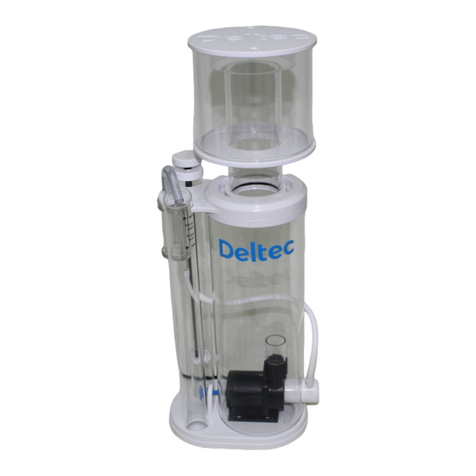
Deltec
Deltec 400i User manual
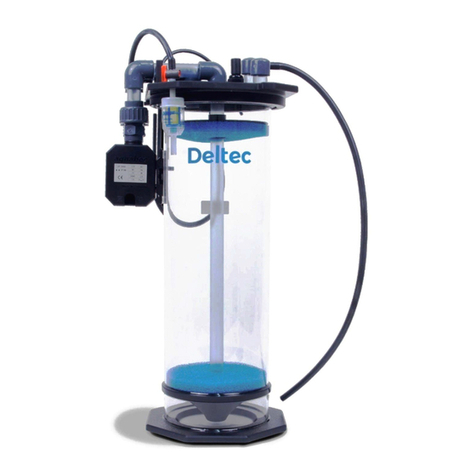
Deltec
Deltec PF 501 Guide
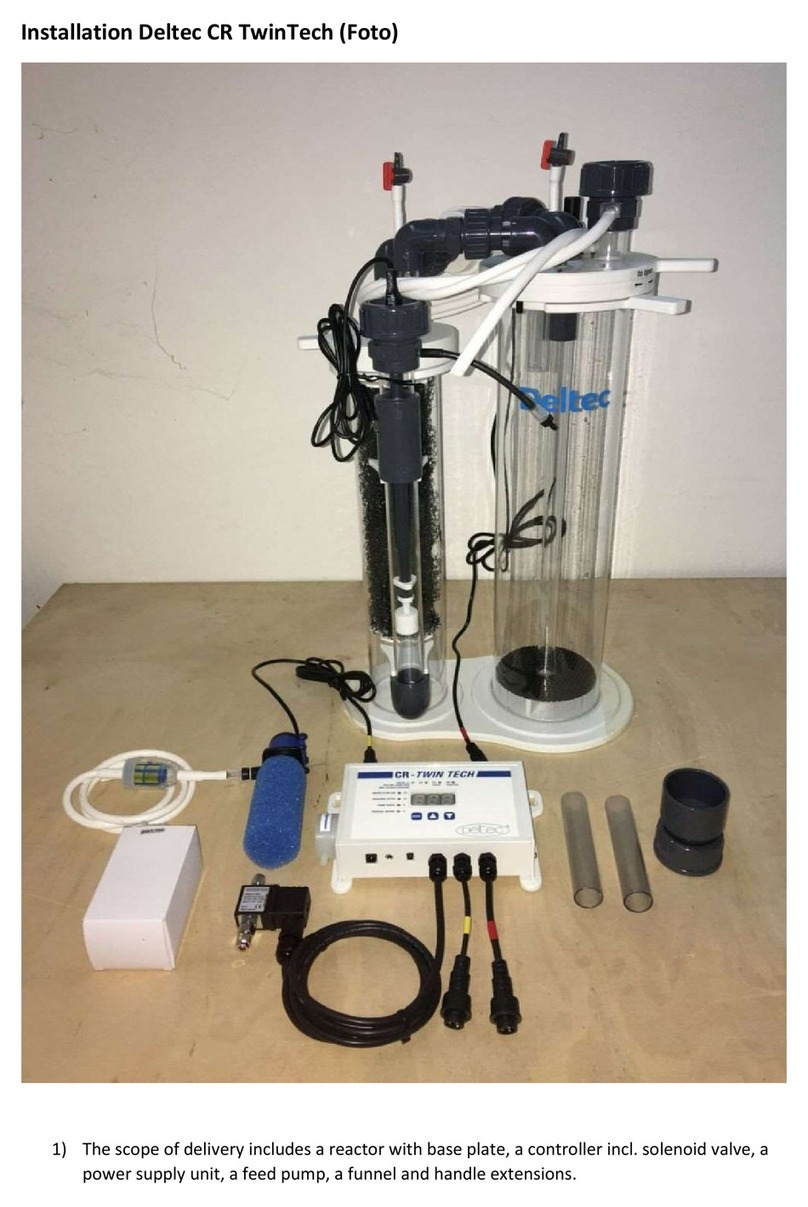
Deltec
Deltec CR TwinTech User manual
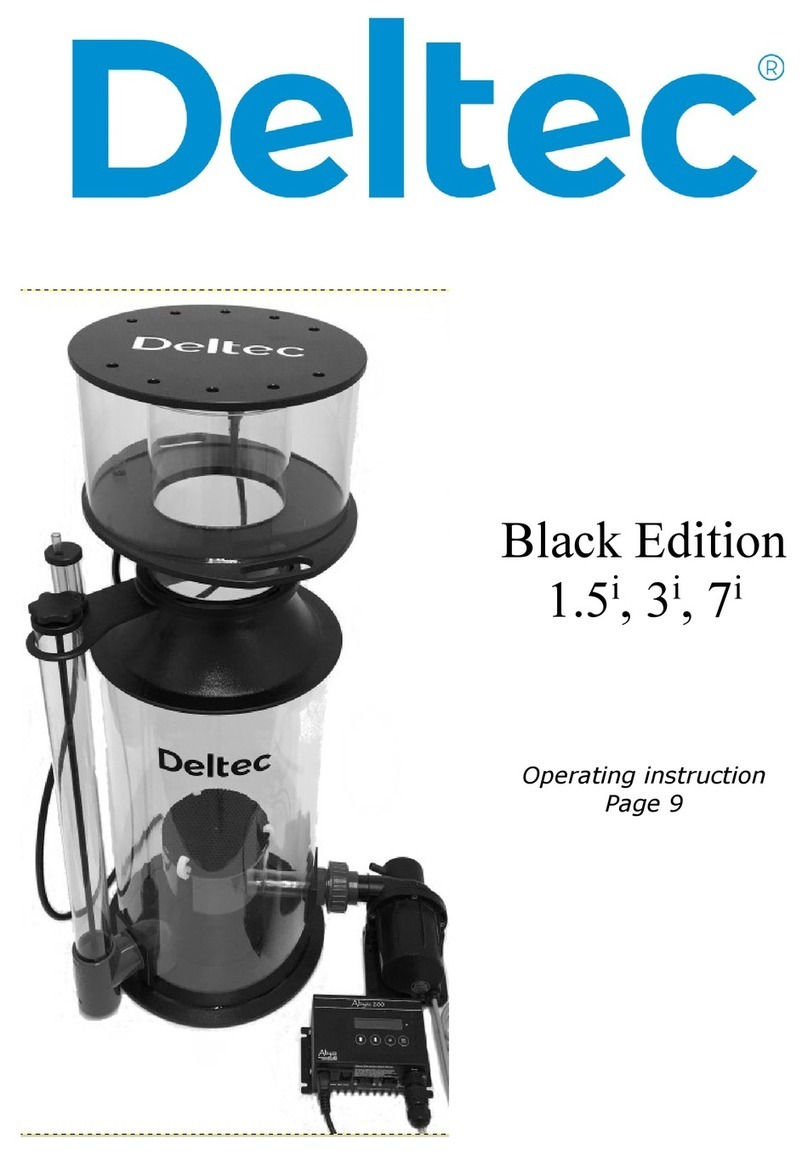
Deltec
Deltec Black Edition 1.5i User manual

Deltec
Deltec Aquastat 1001 User manual

Deltec
Deltec KM 500 Guide
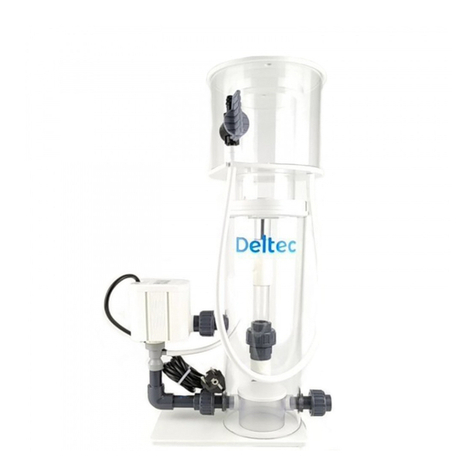
Deltec
Deltec TC 1000ix User manual
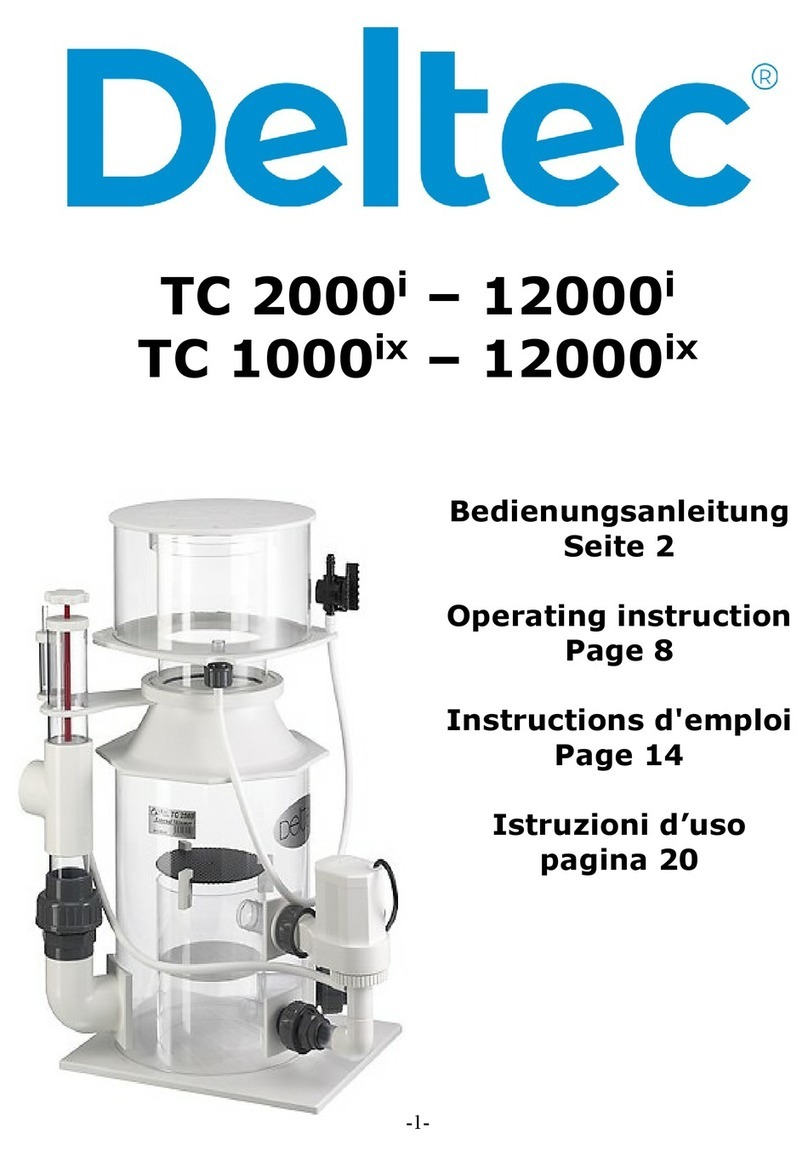
Deltec
Deltec TC 1000ix User manual

Deltec
Deltec TC 2000ix User manual

Deltec
Deltec 400i User manual
Popular Aquarium manuals by other brands
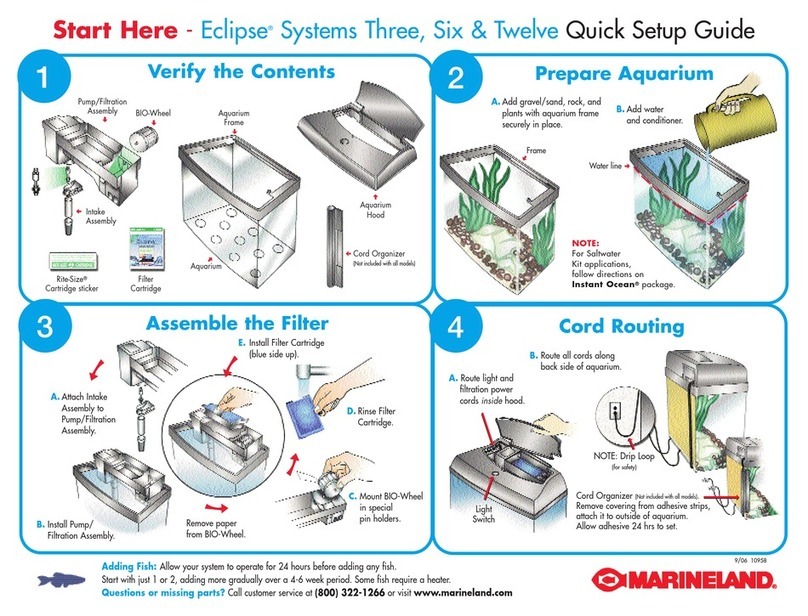
Marineland
Marineland Eclipse Three Quick setup guide
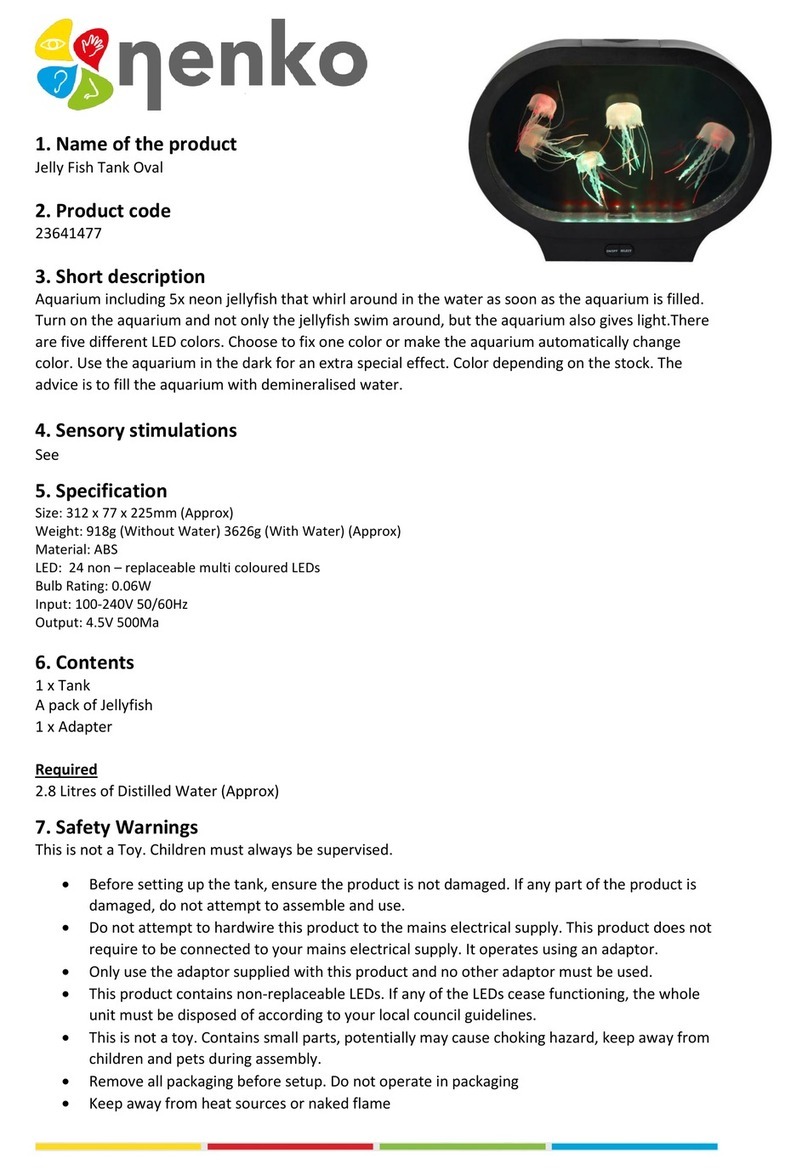
NENKO
NENKO Jelly Fish Tank Oval quick start guide
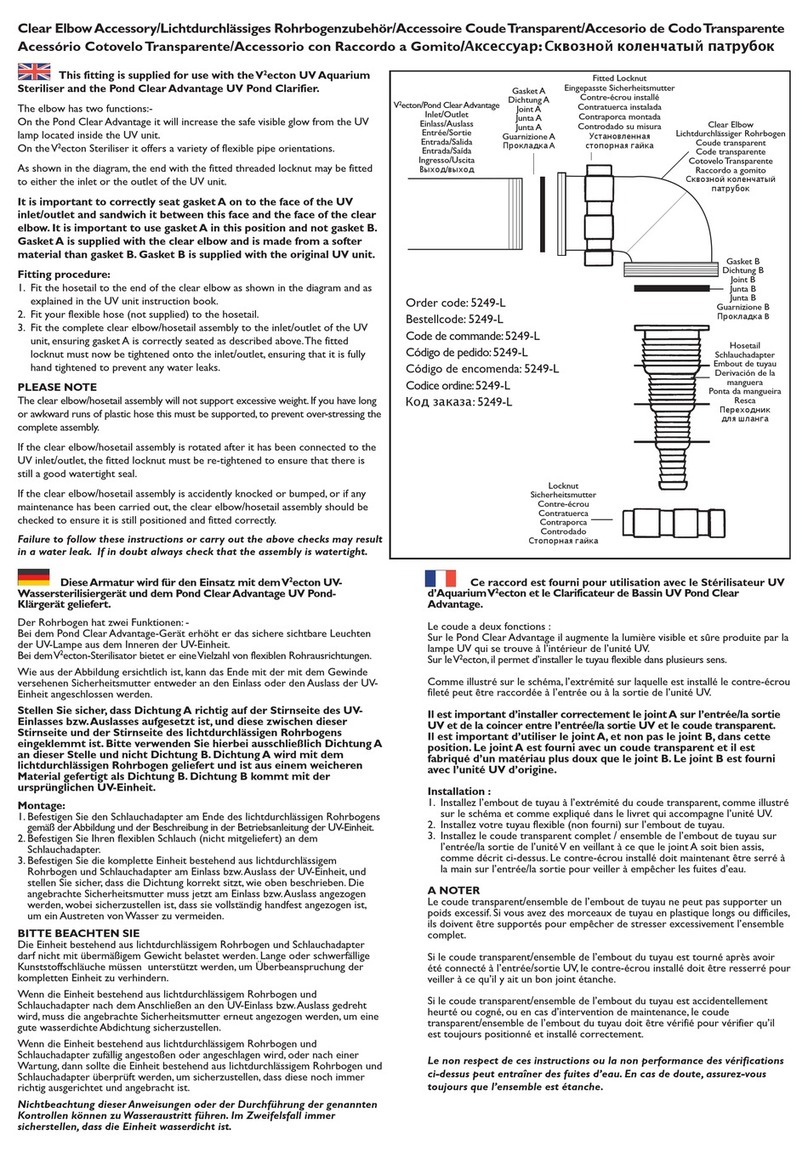
TMC Aquarium
TMC Aquarium 5249-L instructions

Sera
Sera Marin Protein skimmer 600 S INFORMATION FOR USE
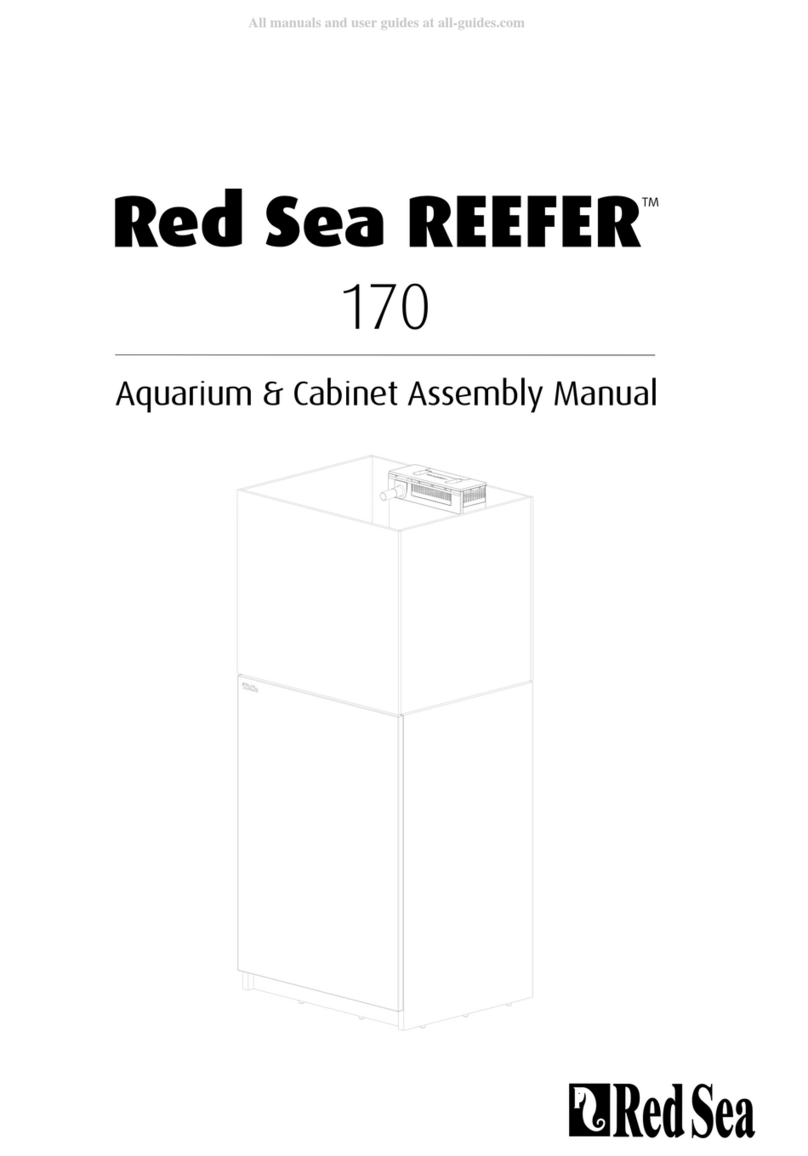
Red Sea
Red Sea REEFER 170 Assembly manual
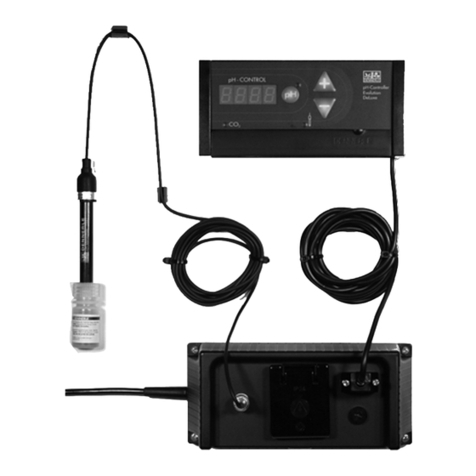
Dennerle
Dennerle Profi-Line Evolution DeLuxe operating instructions

